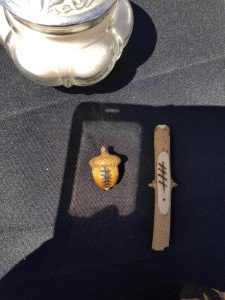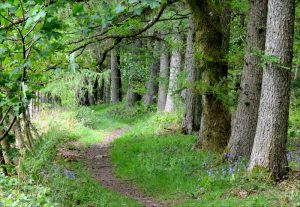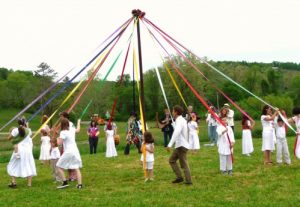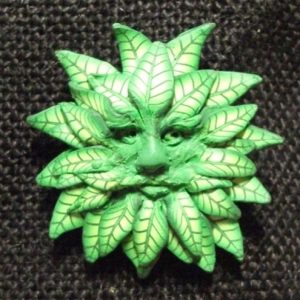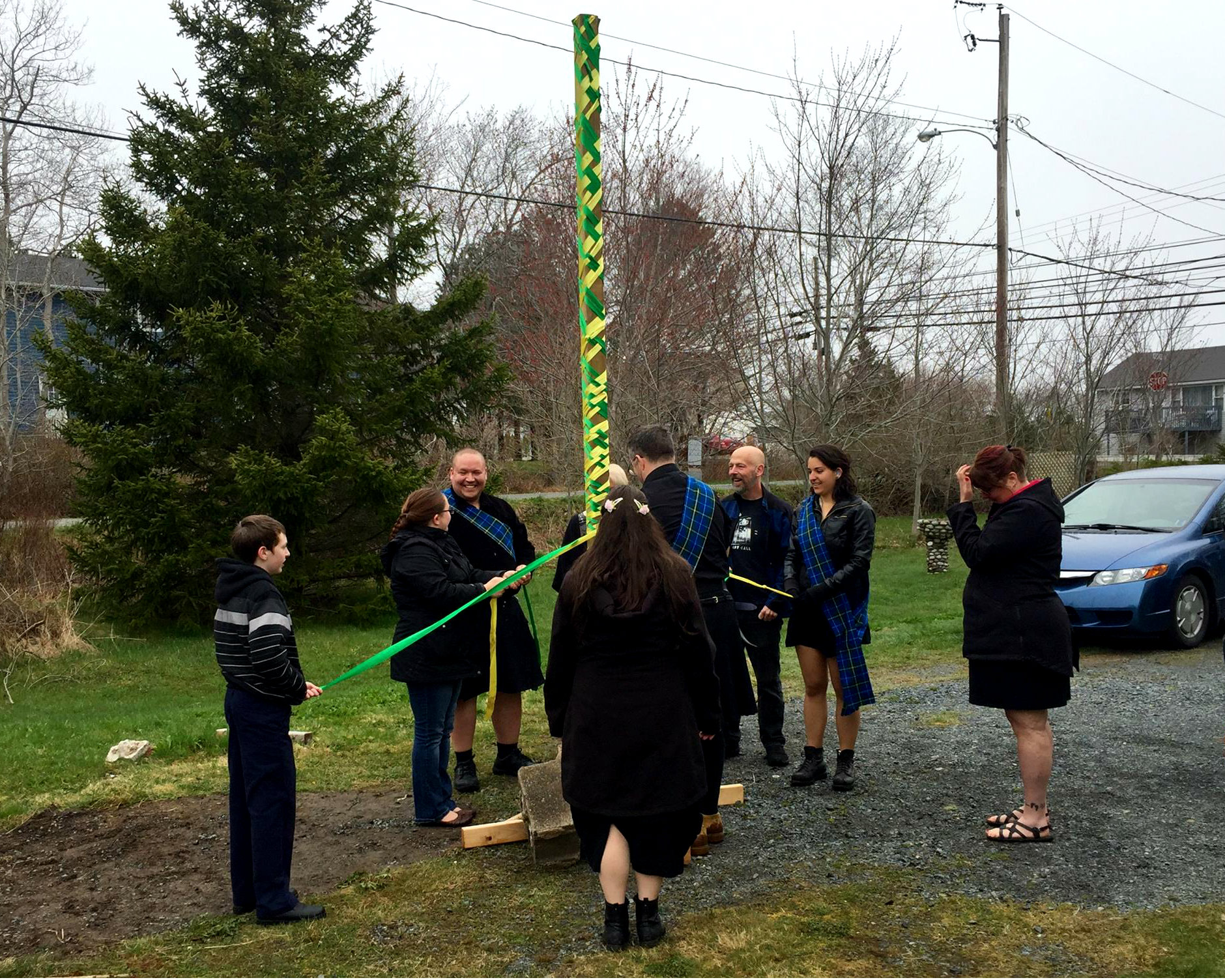
BLOG
Beltane Ritual
Beltane was a great time. We danced the may pole, shared delicious snacks, and had a wonderful ritual with Grove and friends.
During the ritual, we pulled two Oghams as usual and were met with the following: Blackthorn, which represents challenges, difficulty, and poison, followed by Yew, which represents access to ancestors, death, rebirth, and faith. Suffice to say, from great challenges come lessons, new life, and rebirth. We will embrace the challenges that are coming to us, knowing that the outcomes will be worth the efforts and struggle.
Good luck to you all with your Spring and Summer ventures and Blessed Beltane!
Beltane Activities
Beltane is just around the corner and I know you are all looking for family-friendly activities to celebrate. Beltane is a time to celebrate fertility and, while you may not want to beat your children over the head with this (so to speak), you do want them to understand it brings life and all the things they love about spring and summer.
Here are some fun group and family-friendly activities you can do to celebrate.
Crafts:
Make a floral crown or cone. Teach the children to be respectful of what they harvest and to do so mindfully. (Adults, you need to remember this too!) For your pretty flower crown or bouquet, something is dying. If you are not a fan of this, try potting a plant to bring inside, and decorate the pot.
Ribbon is also highly associated with Beltane because of the May Pole (which you can always dance by the way), so why not try braiding some ribbon crowns or hanging ribbons from trees to decorate your celebration.
Have a Bonfire:
The Bale Fire is a long-standing tradition used for protection and purification. It is also a fantastic gathering point for stories and celebrations. So why not grab the marshmallows and have yourself a little roast.
Go A-Maying:
Take a walk though the woods and enjoy some of the new life that is budding up around you. You can take pictures, clip trimmings, or draw what you see and maybe even enjoy a picnic in nature. It’s always good to get some fresh air and commune with nature.
Gardening:
This is a great way to introduce your children to the idea of fertility without having to explain the “birds and bees”, if you aren’t quite ready. The seeds breed life and life is all around us. Children can help by tilling and watering the soil. They will gain a sense of satisfaction and acquire new skills through helping with the planting.
Dance that May Pole:
Beltane is all about fertility and fun. What better way to wholesomely celebrate than dancing around a giant phallic object and decorating it? Try to weave your ribbons over-under-over-under to create a beautiful pattern down your may pole. You can also tie wishes for the next year to the pole before wrapping it. Focus on those hopes as you dance, and watch the magic come to life.
Bake a Green Man Cake:
We all love the Green Man and we all love cake! Lets combine the two and enjoy! (Keep scrolling for a recipe!)
I hope this has helped you in deciding what to do with your May Day celebrations. Enjoy!
INGREDIENTS
- 2 1/2 C all-purpose flour
- 1/4 C cornstarch
- 4 tsp baking powder
- 1/2 tsp salt
- 2 tsp cinnamon
- 1 tsp ground nutmeg
- 1 tsp ground cloves
- 1 C milk
- 3 eggs
- 2 tsp pure vanilla extract
- 1/2 tsp rum-flavored extract
- 1 C butter, softened (don’t use margarine)
- 2 C firmly packed brown sugar
- 2 packages cream cheese, softened
- 1/2 C butter, softened
- 2 C confectioner’s sugar
- 1 tsp vanilla extract
- 1 package white fondant
- Green food coloring
- Leaf-shaped cutters
DIRECTIONS
Preheat oven to 350, and lightly grease and flour your cake pan. Mix all dry ingredients together in a large bowl and blend well. In another bowl, combine milk, eggs, vanilla and rum extracts together.
Add the softened butter to the flour mixture, and beat until it forms a clumpy sort of dough. Gradually add the liquid mixture in, blending it a little at a time until all the milk mixture has been combined with the flour mixture.
Beat until completely smooth, and then add the brown sugar. Mix for another thirty seconds or so. Scoop batter into the pan and spread evenly.
Bake for 45 minutes, or until a toothpick inserted in the center comes out clean. Allow to cool completely before removing from pan. Once you have it out of the pan, you can begin frosting the cake.
To make the cream cheese frosting, combine the cream cheese and the butter in a bowl, mixing well. Add the vanilla extract. Finally, stir in the confectioner’s sugar and blend it in. Spread this evenly over the cake, and allow it to sit for an hour or so to firm up.
To make the Green Man himself, you’ll need green fondant. If you’ve never worked with fondant before, it can be a little tricky, but with some practice you’ll be able to use it easily. Roll out the fondant and knead it into a ball. Add the green food coloring in very small amounts and blend it in, until you’ve got the shade of green you want.
Roll the fondant out until it’s about 1/8” thick. Use the leaf-shaped cookie cutters to cut out different sized leaves. Score lines on them, to look live leafy veins. Place them on top of the frosted cake and press in place, layering them to form a Green Man. Roll two small pieces into balls, flatten them down, and put them in to create eyeballs in amongst the leaves. Reminder – fondant tends to dry quickly once it’s rolled out, so only cut off small pieces. The cake in the photo was made using a block of fondant about the size of a package of cream cheese.
Beltane, a personal reflection
This year’s Beltane ritual was my first experience at holding the lead position in a major ritual. Not being accustomed to speaking in front of people, I was fairly nervous going into it, but also looked forward to the experience and the chance to face my fears and the challenge head on. Doing my due diligence, I researched the gods and goddesses associated with this festival, settling on the Welsh goddess Creiddylad and the Irish god Belanus. These deities both seemed to call to me. Belanus being the more obviously associated, being the namesake of Beltane — Bel (Belanus) and tane meaning fire — but also Creddylad, being the goddess of flowers and love and the daughter of the sea god Lir. These two gods seemed to balance and compliment one another like the best relationships seem to do, and being a traditional festival in which to hold marriage ceremonies, this seemed appropriate.

The ritual was going as well as could be expected, given that it was a cold and cloudy day. The rain held off, which was a god sent (pun intended). It was even a bit inspiring seeing the mist of my own breath escaping my lips. Images of the mists of Avalon jumped to mind briefly. Thankfully, I was able to project my lines for all to be able to hear, as that was a concern for me, being a quiet spoken individual by nature.
When the first Ogam was drawn —Blackthorn (“Wounding”) for the Omen— we were all a bit thrown. Were the gods displeased? We didn’t forget any of the offerings. We didn’t skip over anything vital. Why were the gods showing their displeasure at our gifts? So, adding a couple of more offerings to the fire, we drew another Ogam. This time, Yew (“Transition”) was drawn. A little better (and upon later reflection, explaining much). We were all relieved when, in return, the gods blessed us with the Ogam of Apple (“Wholeness”).
I must admit, I was rather thrown in the moment by what had been drawn. I even shed a few tears, but recovered enough to enjoy the maypole dance and other festivities, and then to close the ritual properly. Over the next couple of days, I reflected on the Ogams that we drew, and read over their meanings in greater depth. Blackthorn, although quickly translated to “Wounding”, also “offers initiation into the mysteries of self-conquest and transcendence”. Yew’s main translation, “Transition”, is also known for “transformation, renewal, (and) rebirth. An opening, a new element approaching.” Looking further into Apple was interesting as well. Not only was it’s basic meaning “Wholeness”, a very good blessing indeed to receive from the gods, but also a deep connection to the universe. While reading the section on Apple, a few more unexpected connections popped up. “The apple tree in Celtic myth is associated with Avalon, the Island of Apples,” where King Arthur is said to have gone to heal from “grievous wounds”. Belanus, the festival of Beltane, and the Son of Lir were all also mentioned within Apple’s explanation. The interconnections at play were numerous. Since thoughts of the mists of Avalon had come to mind due to the chill in the air and seeing my breath at the very start of the ritual, it being mentioned in the Apple’s texts was fascinating. For a connection to then appear for both of the deities that I had chosen to call upon, Beltane directly and Creiddylad, daughter of the sea god Lir (and therefore sister of the son of Lir), well, I must say, it felt as if the gods were definitely working their magic.
So, looking at the Ogams drawn for the Omens and Blessings received from the gods, I think that their combined meanings tells a larger story. We may all be wounded in many ways (Blackthorn, wounding), but it is through the healing (Yew, transition) of those wounds that we can become whole again (Apple, wholeness). It’s the point of the human experience really. The greatest lessons in life are often the result of the healing process from traumatic life experiences. This time of year, when the flowers spring forth from the ground and love is in the air, this is a time for transformation and rebirth. A reminder to let go of old wounds and to transition into wholeness. To learn from our experiences and become wholly who we are meant to become, both individually and as a grove.
So say we all.
-Written by Lily M.
(Quotes all taken from Ogam: the Celtic Oracle of the Trees by Paul Rhys Mountfort.)
**photocred: Karen

